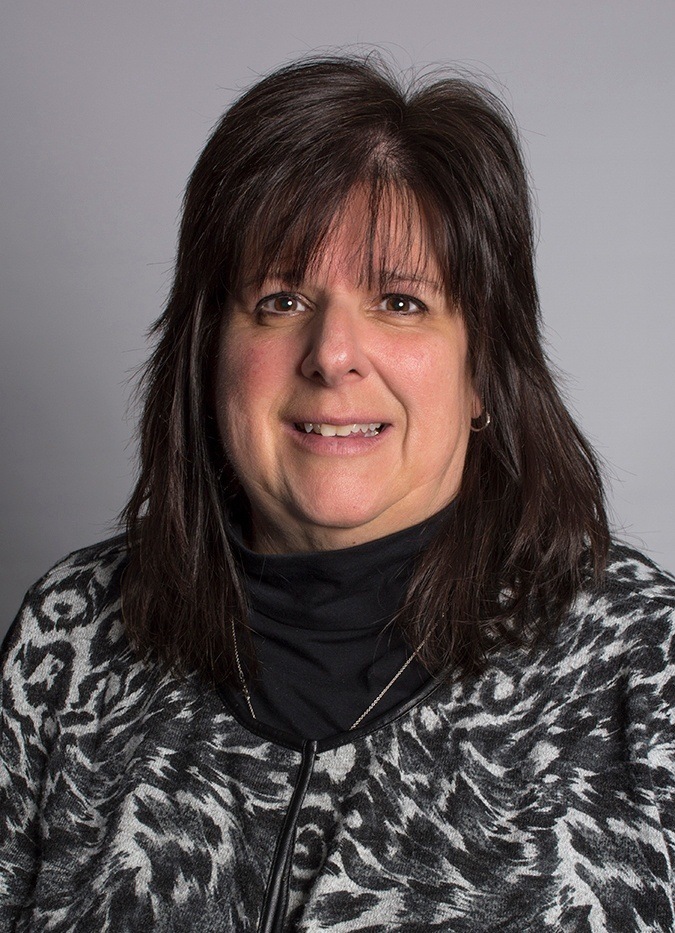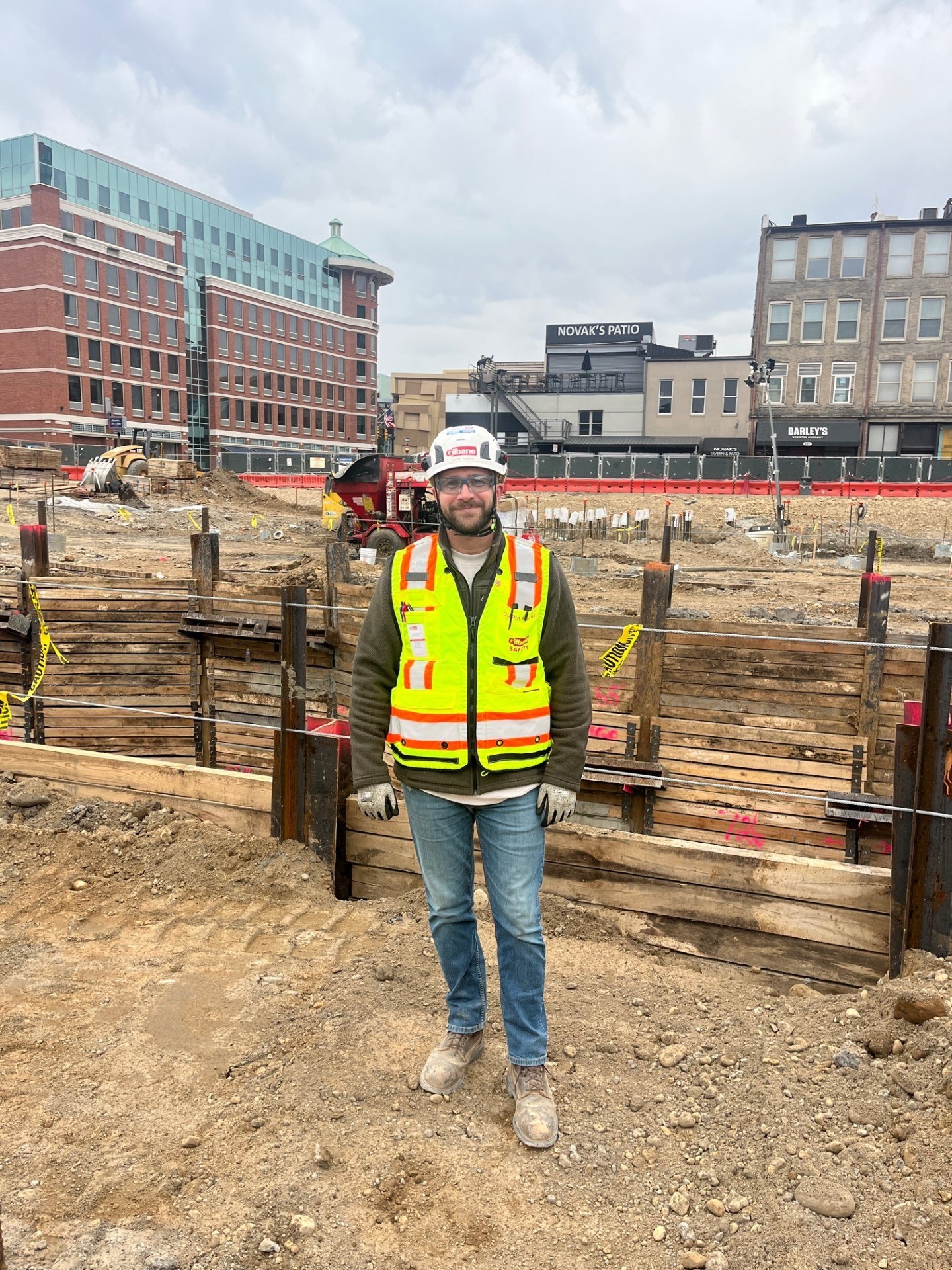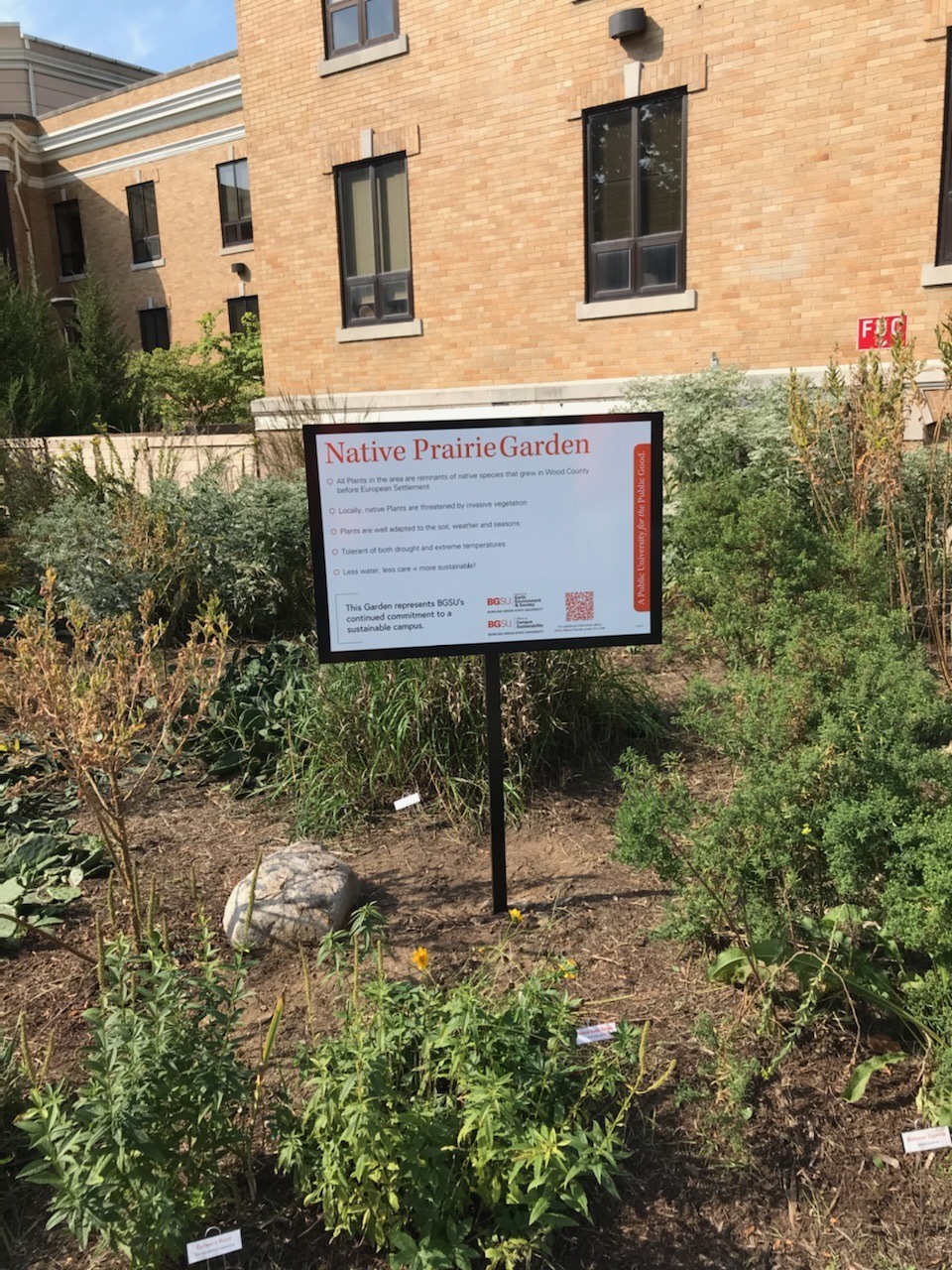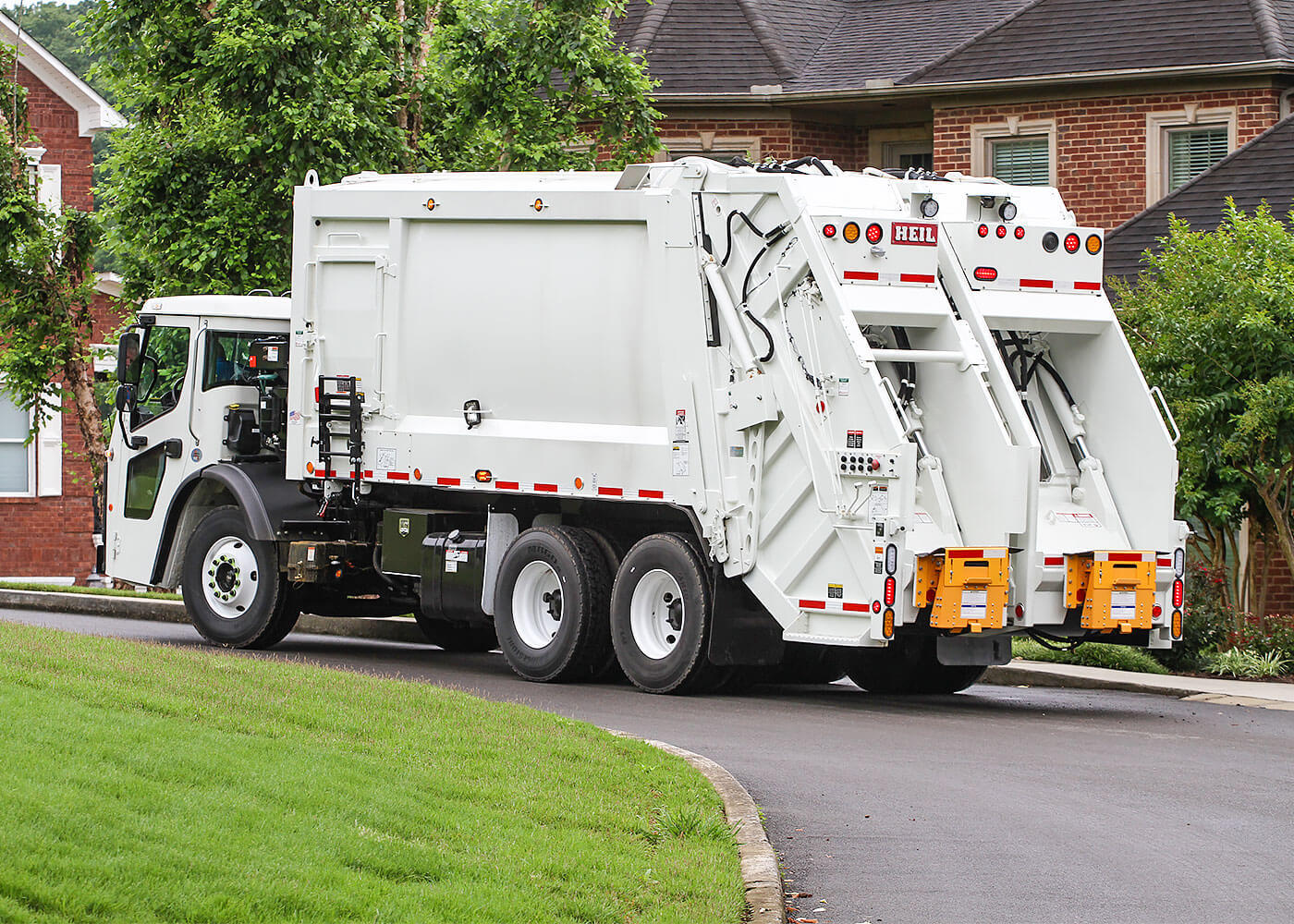Fall 2023 Newsletter

Eco-Hero Spotlight
By: Sean Cook & Zach Nemec
The Eco-Hero Spotlight is an initiative started by Campus Sustainability to actively seek out and recognize individuals or groups that make an Eco-friendly impact on BGSU. Anyone can be an Eco-Hero, so long as they are willing to do what it takes to promote sustainability.
Fall 2023's Eco-Hero is BGSU's Dr. Donna Trautman.
Dr. Donna Trautman, or Donna as she prefers, is an Associate Professor of Visual Communication Technology in the College of Technology, Architecture, and Applied Engineering at Bowling Green State University. She came to BGSU as an undergraduate, majoring in biology from her hometown southwest of Cleveland, but with biology not being her cup of tea, she switched over to majoring in Visual Communications and Technology (VCT). This led her to obtain her undergraduate and master's in VCT, both received at BGSU. Now a two-time BGSU alumnus, she began her teaching career at both Illinois State University, and The Ohio State University, but she eventually decided to come back to BGSU even after receiving four job offers from other institutions. “I didn’t really expect to be doing it for so long, but I ended up loving the major and the program we have here at BGSU.” About 15 years ago, she started thinking about how photos, videos, the internet, and printing, could be used to promote sustainability. She believes that technology majors are not given many opportunities to be exposed to the concept of sustainability even though they have a big impact. However, she believes there are many ways that VCT can be used to influence environmental education as well as their direct impact on the environment from printing, energy usage, and electronics. VCT majors have the unique opportunity to have a positive impact on the environment in many ways without needing to sacrifice extra effort. To highlight this importance, she contacted industry partners whom she has previously worked with and riddled a scenario of whether they are more inclined to hire a sustainably-minded applicant than not. Fortunately, about 90% of the partners said they would want to hire a sustainably-minded applicant.
Donna has teamed up with the Office of Campus Sustainability on several occasions, the latest being for a sustainability grant from the Ohio EPA. Her attendance at an online seminar in October 2021 about potential grants for colleges in areas of recycling and litter prevention led to the collaboration with Dr. Hennessy. This resulted in research and design for sustainable adhesive stickers and posters, to be placed on walls and tables for students and staff to read and be informed about the sustainability initiatives on campus, as well as filmography and other forms of VCT aimed at reducing contamination in recycling.
One of the challenges Donna is facing about sustainability is the revolving door of students that need to be taught from square one. Even though more people are getting interested in sustainability and the environment, new students still need to be taught the same things, or to have certain inaccurate beliefs corrected. To combat this, Donna has tried to integrate sustainable ideas into her courses. “Sustainability as a concept isn’t very controversial, it’s resource protection.” One of the ways she does this is by having her students design more sustainable packaging. She assigns a project in her media classes for students to re-design the packaging of a product of their choice. During the design process of this project, students ask themselves questions such as: “What types of materials can we use to replace this packaging to make it more sustainable?” or “How much of this packaging is wasteful, and how much can we reduce before the product will be affected by less protection?” These types of questions get the students thinking about why there is so much unnecessary packaging on diverse types of products around them, and that technology can be used to make these techniques in packaging more efficient and effective. Donna also enables VCT majors to support sustainability practices through web design. For example, darker colors require less energy to be projected than brighter colors, so having a darker background on a webpage will use less energy and have a lower overall carbon footprint.
Now that Donna has been working for some time, she is very thankful for having such sustainably minded parents, as this formed the foundation of her sustainable knowledge she is using in teaching, and spreading that knowledge forward is of most importance to her. She believes that getting creative and involved on campus are great ways to introduce sustainability to students and are just the beginning of making BGSU a more sustainable campus. “Students should first become aware of their own personal and professional impact and contribution. Most people only recycle when it is convenient. Being aware of the environmental problems changes the culture of the university and can yield change over time.” She even has more advice for current and future generations of BGSU students about the environment, saying “to do the right thing and to get educated about sustainable practices.” She is a notable example of how sustainability can be integrated into many different subjects of teaching without compromising on the subject material itself.
Thank you, Dr. Donna Trautman, for being an Eco-Hero and for all that you have done to teach and model sustainability at BGSU.
Where Are They Now?!
By: Jordyn Morley
Over the years, many interns have walked in and out of The Office of Campus Sustainability doors. These interns have made major contributions and impacts that have marked successful milestones for the Office of Campus Sustainability. We wanted to know what these interns have been up to and how the work they did as an intern has impacted their lives. Therefore, we started the newsletter series- “Where Are They Now?!”

This October, The Office of Campus Sustainability reconnected with former intern, Dustin Hawkins.
Dustin graduated from Bowling Green State University in 2012 with a Bachelor’s of Science degree in Environmental Policy with a minor in Sustainability.
Campus Sustainability Intern (2011-2012)
Dustin currently works as a Project Safety Manager at Gilbane Building Company. At Gilbane he manages and ensures that all trades are working safely throughout various jobsite. He also is a resource for all OSHA laws, regulations, and policies. He is currently working on a construction project in downtown Columbus. This project is a 32-story building featuring a parking garage, vendors and event spaces, apartments, and a hotel. Dustin is recently married and bought a home where he plans to raise his family! Although his current job does not center around sustainability Dustin has made a concise effort to implement different environmental measures in his professional and personal life. At work he implemented a recycling program on various jobsites and at home, Dustin and his wife recycle anything that they can. They have also incorporated ways to help conserve energy by not using heating/cooling as much, eating homegrown vegetables and eating at home as much as possible to prevent excess packaging.
Dustin played a key role in implementing The Green Tailgate program now known as “Green Game Day.” He started working on the Green Tailgate his junior year with Dr. Nick Hennessy, Manager of Sustainability. During his internship he would gather all recycling equipment, green recycling bags and help in packing up the truck every game day morning. He would go through the tailgating area and set up the recycling equipment and help distribute bags. Dustin also helped with other recycling ventures across campus including Eppler, the Rec Center and the Student Union and every Tuesday and Thursday he would collect them, and sort through the different items students had recycled. Dustin also enlisted other students in helping him to make BGSU more sustainable by planning, organizing, and training them on how to record and collect recyclables from these buildings.
“I actually loved my time during my internship,” Dustin said during the interview. He emphasized that he genuinely enjoyed working for the Office of Sustainability. He liked being able to educate new people about the Green Tailgate and waste reduction. Although Dustin enjoyed his work, he faced social challenges in watching friends and family tailgate and have fun whereas he was working long hours. Although Dustin did not have too many crossovers with staff within the Office of Sustainability as there were not many other interns at the time, he still learned tons and has fond memories of the golf cart rides and free pizza with Dr. Nick.
Dustin’s current profession he is working on multiple different projects with his company and even works on a project at BGSU. Gilbane Building Company is currently working on the air conditioning project at McDonald Hall. During the summer, Gilbane installed the underground chilled water loop and completed the walks on North College Drive in front of McDonald / OAKS. Gilbane mobilized the inside of McDonald Hall on August 14th. They are currently demoing the old pipes above the ceiling and core drilling holes for the new piping. They will also be replacing all the carpet in McDonald Hall and aiming for completion by July 29, 2024. Once they complete, they will be moving over to Kohl Hall to complete the same HVAC Project from August 2024 – April 2025.
Dustin was extremely happy with his internship experience. He learned that when you work on something you love, it does not feel like work and that small groups of people can really make a change when it comes to sustainability. As a BGSU graduate Dustin has a word of advice that “even if you cannot find a career in the environmental field you can still incorporate sustainability/environmental aspects in your everyday life.”
On behalf of the Office of Campus Sustainability, thank you, Dustin, for helping build the Green Game Day program into what it is today

Revamping The Shatzel Hall Native Prairie Garden
By: Zach Nemec
The Shatzel Hall Native Prairie Garden received quite the upgrade in plant diversification and aesthetics, boasting more Ohio native plants, a new welcome sign, and plant identification stakes with scientific names, all for students to see when walking on campus. This further increases BGSU’s commitment to become a more sustainable campus as a part of their Climate Action Plan by spreading awareness and education about sustainability.
Colder weather and fall breezes prove no match for prairies in Ohio, and what better prairie is there to look at than BGSU’s own Shatzel Hall Native Prairie Garden. One of three prairie environments, this garden is home to a new grand total of 23 different, Ohio native plant species, most of which can be found in Northwest Ohio. Numerous plant species you may not have heard of include the Ohio Spiderwort, Rough Blazing Star, and Prickly Pear Cactus, among others. Yes, there are cacti in Ohio, who knew?! With winter quickly approaching, this garden will remain dormant in the colder months, however, this does not mean it will be gone forever. Prairies are very resilient, especially eastern prairies such as this one, as they block cold temperatures and snow from reaching the root systems which remain active in the winter.
This Native Prairie Garden received a revamp this fall with the addition of a brand-new welcome sign, individual plant identification cards, and 10 new Ohio native plants species from the Garden for Wildlife program of the National Wildlife Federation! The Office of Sustainability worked hard to deliver a perfectly cared for, prairie garden over the summer, with sustainable service projects that aided in restoration cleanup and maintenance. But the work has just begun. Moving into the fall semester, a new order of plants for the prairie resulted in the planting of new plant species such as Orange Butterfly Milkweed and Foxglove Beardtongue. Invasive plant removal continues to be a top priority in the prairie space, such as thistle, which can obstruct native plant growth and presence. To aid in this task, mulching is a much needed and necessary action to stop invasive growth and make the prairie visually appealing. Come summertime next year, these new plant additions will be sprung and grown, showcasing their colors and vibrancy to students and staff alike as they walk past.
The brand-new welcome sign is a big upgrade from the last, boasting quick informational bullet points, campus logos, and most importantly, a QR code, sending you to the BGSU Native Prairie Garden webpage on the Sustainability website. This new sign was brought to you by a collaboration between the Office of Campus Sustainability, and the School of Earth, Environment, and Society. As well, the Environmental Action Group (EAG) helps oversee the progress of the prairie, even aiding in some sustainable service projects to tend and care for the plants. The EAG also added some native plants this past spring with the help of the Student Green Initiatives Fund.
Shatzel Hall is also in the planning stage of getting a live roof, situated right next to the prairie. This live/green roof will be roughly 200 square feet and will be constructed in spring 2024. This will make Shatzel Hall the third building on campus with a live roof, following both the Oaks and Carillon Place. Green roofs are essential in making a new or existing building more sustainable, dramatically decreasing the heat island effect upon asphalt rooftops, and providing a habitat for pollinators and plants. Not only do they also reduce the required amount of energy a building uses for internal temperature control, but by adding another habitat for pollinators and insects, this further increases the biodiversity on campus that will help plants and grasses thrive. While this green roof will be smaller in size and primarily used as a demonstration and educational piece to promote green roofs, it will certainly provide benefit to the natural ecosystem and promote sustainability at BGSU. With this new green roof situated at eye level from the sidewalk, you will be able to visualize the importance of the site when walking to class, as well as numerous pollinators.
Re-Thinking Recycling: How You Can Help BGSU Recycle Right
By: Zachary Hayes
Do you trust that what you put in the recycling bins at BGSU actually gets recycled? Well, it does! But, to give you additional confidence, I reached out to Rachel Sizer who was the keynote guest speaker for the Sustainability Leadership Certificate for the Fall 2023 session where she presented on the topic of recycling to the group.

Example of a split-body truck, which can handle two waste streams simultaneously.
Reduce, Reuse, Recycle – the three R’s of sustainability. Perhaps you’ve heard this mantra before. Did you ever notice how “Recycle” is the last on the list? That’s because Recycling is meant to be the last resort to reduce solid waste before it is inevitably landfilled. The primary way to live more sustainably is to reduce your overall consumption. The more ‘minimal’ you can be, the lower your carbon footprint is. Reusing items is also preferable to recycling. Reusing or repurposing is preferable to recycling because that takes much less energy than recycling the items. Recycling takes materials that were presumably used by the consumer and transforms them back into their raw form so that they can be processed into new materials again. BGSU encourages everyone to reduce consumption – print less, turn off lights when unnecessary, not taking more than they can eat from the dining halls, and more. We all encourage reuse through the Campus ReStore that either gives donated items to charities or back to students throughout the semester. BGSU Falcons are likely most familiar with recycling as that is the most ubiquitous form of waste reduction on campus. We have recycling bins across campus, indoors and outdoors, and orange dumpsters where it all goes.
As of July 1, BGSU has a new name on our trash and recycling dumpsters: Rumpke. Maybe you didn’t even notice this change, but last year BGSU was contracted with Waste Management. Rumpke handles our landfill waste and recycling, and there are several changes.
Orange Dumpsters:
They are for ALL of our comingled recycling now, not just cardboard like last year. That means your UNBAGGED and CLEANED recyclables: glass, metal cans (aluminum or steel, plastic (bottles, jugs, tubs, and cups with lids), all go in the orange dumpsters now.
Cups:
Rumpke’s facility in Columbus processes paper and plastic cups, something our former recycler didn’t do. These cups can be paper or clear plastic (think Starbucks’ cold drinks) and are empty and contain as little residue as possible. DO NOT attempt to recycle red Solo® cups as they are not accepted.
Cartons:
For these, think of the almond milk cartons or a Hi-C® juice box that you see with a recycling symbol on it. These are not recyclable in all jurisdictions, but they are now at BGSU as long as they are cleaned/empty and have the cap removed.
Rachel Sizer is the Wood County Solid Waste Management District representative, a BGSU Alumni, and an expert on recycling. I asked Rachel a few questions related to recycling.
Zach:
What are the main items of contamination found that you see in recycling?
Rachel:
I can only speak for what I see in our containers during my site visits. The most prominent contaminant we see is plastic bags. Items in single-stream programs are meant to be placed in the container loose. These plastic bags can be recycled, just not with our program. When the plastic bags arrive at the Material Recovery Facilities (MRF) they are immediately pulled off the line and landfilled. These facilities are not able to take the time to cut the bags open or risk their safety by opening mysterious bags. Some of the other main contaminants include food items, random hard plastics, and tanglers.
Zach:
What myths do people hold about recycling?
Rachel:
The most persistent myth people believe about recycling is that it doesn’t happen at all! That is not the truth. There is no single reason that explains why people believe this, but I can offer you a few. In 2018 the Chinese policy, Operation National Sword came into effect. During this time, the United States lost its processor. The recycling collected in the U.S. had nowhere to and for a time recycling was not happening at the scale it was before. I am not saying recycling stopped completely, everywhere, it was just greatly limited. During the adjustment period, a lot of recycling ended up in landfills.
The next major reason in my opinion is confusion! People watch similar-looking trucks pick up both their trash and recycling. Trucks that are split into two compartments exist, where one side of the truck will take the trash, and the other will take the recycling. The two compartments are separate but exist on the same vehicle. Also, most companies will maintain similar-looking vehicles in their fleet, using trash trucks and recycling trucks that visually look the same. This can be confusing to people, as they may think they’re the same truck taking everything to the landfill when they are not.
Zach:
Does a load of recycling ever get rejected and is there a rejection threshold for contamination?
Rachel:
I am not aware of any rejection threshold when it comes to our recycling. What I will say is that hazardous wastes or liquid contamination could potentially ruin a load. For example, if oil or pain spills over an entire load, it is safe to say, that nothing in that load will be able to be recycled. It is vital to have high-quality, clean materials for recycling. If the material is dirty, contaminated and already being broken down, it will not produce a quality end-use. The county does not process its own recyclables, so we are not necessarily able to comment on those matters.
Based on her response to my last question about contamination, it is safe to say that at BGSU, we should continue to strive for the delivery of uncontaminated, high-quality recyclable materials for Rumpke to process and sell to manufacturers that can use the recycled content in their products.
Special Recycling:
Plastic bag recycling is something that Campus Sustainability also maintains at BGSU. Clean plastic bags can be recycled in 2 locations on campus: the first floor of the Union and the lobby of Falcon Heights. They can also be taken to most local grocery stores.
E-waste, batteries and used printer cartridges are also recycled. We will recycle “anything with a cord” through our contractor AIM Ecycling. AIM is based in Toledo and is an R2 certified e-waste recycling center. These items are not to be put in the orange dumpsters with your other recyclables. You can also arrange a special pickup for large items. All of that can be done on our webpage here: Electronic Waste Recycling (bgsu.edu).
Hopefully this article has given you renewed confidence in BGSU’s recycling system. It is up to all students, faculty, and staff to help us achieve our recycling and carbon reduction goals. We have many resources for recycling on our website and, as always, you can contact us at greenbg@bgsu.edu with additional questions.
Sustainability Questions & Suggestions
Do you have any questions, comments, concerns, or suggestions related to sustainability? If so, feel free to contact us at greenbg@bgsu.edu. Alternatively, you can reach us on Facebook, Twitter, or Instagram @GreenBGSU.
We look forward to hearing from you!
Like staying up to date on all of BGSU's sustainability updates? Be sure to subscribe to our newsletter to get it sent to your email inbox each month!
Updated: 01/19/2024 01:02PM
